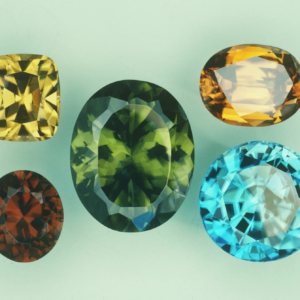Tremolite


Tremolite,Campolungo, Piumogna Valley, Switzerland
Tremolite from Franklin, Sussex Co., New Jersey, United States
Tremolite is a silicate mineral and member of the amphibole group. Chemical formula is Ca2(Mg5.0-4.5Fe2+0.0-0.5)Si8O22(OH)2. A calcium magnesium silicate, tremolite forms a solid-solution series with ferroactinolite, where iron substitutes in increasing amounts for magnesium. The color of tremolite varies with increasing iron content from colorless to white in pure tremolite to gray, gray-green, green, dark green and nearly black in other specimens. Traces of manganese may tint tremolite pink or violet. When well-formed, crystals are short to long prisms. More commonly, tremolite forms unterminated bladed crystals, parallel aggregates of bladed crystals, or radiating groups. Tremolite and actinolite both form thin, parallel, flexible fibers up to 10 in (25 cm) in length, which are used commercially as asbestos. Tremolite is known as nephrite jade when it is massive and fine-grained. The mineral is abundant and widespread. It is the product of both thermal and regional metamorphism and is an indicator of metamorphic grade because it converts to diopside at high temperatures (1,065°F/575°C or above).
Fibrous Tremolite: one of the six identified varieties of asbestos. About forty, 200 tons of tremolite asbestos is mined yearly in India. it’s miles otherwise found as a contaminant.
Name: Tremolite is derived from the Tremola Valley near St. Gothard, Switzerland. Actinolite comes from two Greek words meaning a ray and stone, in allusion to its frequently somewhat radiated habit.
Association: Calcite, dolomite, calcian garnet, wollastonite, talc, diopside, forsterite, cummingtonite, magnesio-cummingtonite, riebeckite, winchite.
Polymorphism & Series: Forms a series with actinolite and ferro-actinolite
Mineral Group: Amphibole (calcic) group: Mg=(Mg + Fe 2+) ¸ 0.90; (Na + K)A < 0.5; NaB < 0.67; (Ca + Na)B ¸ 1.34; Si ¸ 7.5.
Crystallography: Monoclinic; prismatic. Crystals prismatic in habit; the prism faces make angles of 56° and 124° with each other. The termination of the crystals is almost always formed by the two faces of a low clinodome (Figs. 400 and 401). Tremolite is often bladed and frequently in radiating columnar aggregates. In some cases in silky fibers. Coarse to fine granular. Compact
Tremolite Composition: Ca2Mg5Si80 22 (0 H )2, is an end member of an isomorphous series. Iron may replace magnesium in part, and when present in amounts greater than 2 per cent, the mineral is called actinolite
Tremolite Diagnostic Features: Characterized by slender prisms and good prismatic cleavage. Distinguished from pyroxenes by the cleavage angle and from hornblende by lighter color.
Contents
- Chemical Properties
- Tremolite Physical Properties
- Tremolite Optical Properties
- Occurrence of Tremolite
- Tremolite Uses Area
- Distribution
- References
Chemical Properties
| Chemical Classification | Inosilicates |
| Formula | {Ca2}{Mg5}(Si8O22)(OH)2 |
| Common Impurities | Ti,Mn,Al,Na,K,F,Cl,H2O |
Tremolite Physical Properties
| Crystal habit | Elongated prismatic, or flattened crystals; also as fibrous, granular or columnar aggregates |
| Color | White, brown, colourless, grey, light green, green, light yellow, pink-violet |
| Streak | White |
| Luster | Vitreous, Silky |
| Cleavage | Perfect on {110} |
| Diaphaneity | Transparent, Translucent |
| Mohs Hardness | 5 – 6 |
| Crystal System | Monoclinic |
| Tenacity | Brittle |
| Density | 2.99 – 3.03 g/cm3 (Measured) 2.964 g/cm3 (Calculated) |
| Fracture | Splintery |
| Parting | on {010} {100} |
Tremolite Optical Properties
| 2V: | Measured: 88° to 80°, Calculated: 82° to 84° |
| RI values: | nα = 1.599 – 1.612 nβ = 1.613 – 1.626 nγ = 1.625 – 1.637 |
| Twinning | Simple or multiple: common parallel to {100}, rarely parallel to {001} |
| Optic Sign | Biaxial (-) |
| Birefringence | δ = 0.026 |
| Relief | Moderate |
| Dispersion: | r < v weak |
Occurrence of Tremolite
Tremolite is most frequently found in impure, crystalline, dolomitic limestones where it has formed on the recrystallization of the rock during metamorphism. It is also found in talc schists. Actinolite commonly occurs in the crystalline schists, being often the chief constituent of green-colored schists and greenstones. Frequently the actinolite of such rocks has had its origin in the pyroxene contained in the igneous rock from which the metamorphic type has been derived.
Tremolite Uses Area
The fibrous variety is used to some extent as asbestos material. The fibrous variety of serpentine furnishes more and usually a better grade of asbestos. The compact variety nephrite is used largely for ornamental material by oriental peoples
Distribution
Notable localities include:
- Campolungo Alp, Ticino, and Bristenstock, Uri, Switzerland.
- From St. Marcel, Piedmont, Italy.
- At Bilin, Czech Republic.
- In the USA, from pont, Gouverneur, Edwards, and Macomb, St. Lawrence Co., New York; at Franklin, Sussex Co., New Jersey; and Lee, Berkshire Co., Massachusetts.
- At Wilberforce, Ontario, Canada.
- From Kozano, Badakhshan Province, Afghanistan.
- At Lelatema, Tanzania.
- In the Brumado mine, Bahia, Brazil.

Leave a Reply
Want to join the discussion?Feel free to contribute!